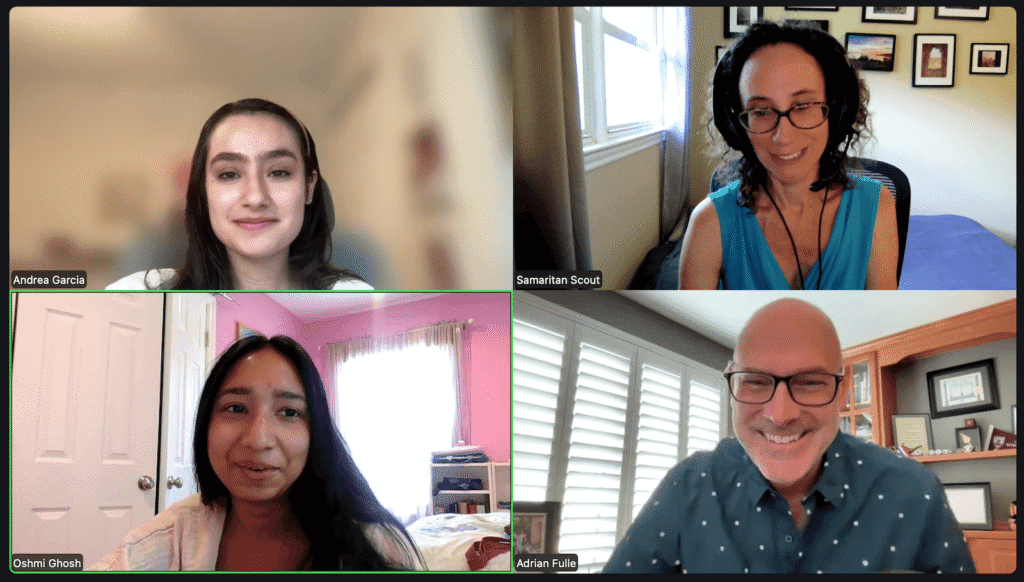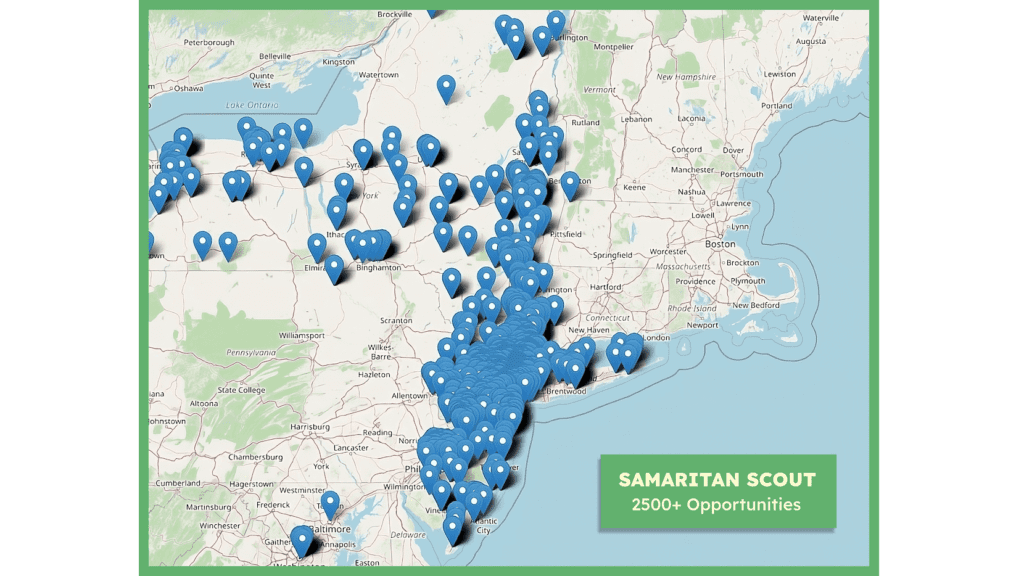At Samaritan Scout, we believe in the power of people helping people—and that starts with our own team. As the Internet’s only search engine dedicated exclusively to connecting people with in-person volunteer opportunities, Scout focuses on community service that supports our local communities.
This summer, we’re proud to be joined by two exceptional marketing interns: Andrea Garcia, of Rutgers University and Green Brook, NJ, and Oshmi Ghosh, of NYU and Edison, NJ. Together, they’re helping spread the word about Scout’s mission to make meaningful volunteer opportunities more accessible across the country.On Wednesday, July 23, Andrea and Oshmi had a rare opportunity to learn directly from a seasoned marketing leader. Adrian Fulle, a distinguished marketing executive with a career spanning Hollywood storytelling and corporate brand strategy across multiple industries, generously volunteered his time to meet with our interns.
Part masterclass, part mentorship hour, Adrian’s session was packed with professional insight, personal stories, and practical advice. From his creative beginnings as a filmmaker to leading marketing for companies with over $1 billion in revenue, Adrian shared lessons from his journey—and answered our interns’ thoughtful questions with candor and encouragement.
From Hollywood to Marketing: Adrian’s Story
Adrian opened the conversation by sharing his inspiring and unconventional career journey. Originally a filmmaker and screenwriter in Los Angeles, Adrian spent over two decades in the entertainment industry, including producing and directing independent films, commercials, and music videos.
In 2016, he was tapped by Variety Magazine to build their in-house content studio, where he led award-winning brand campaigns for major global advertisers across entertainment, tech, and lifestyle sectors.
But eventually, as he put it, “I lost my passion for the entertainment industry. . It became just a business.” Encouraged by his wife and searching for a new direction, Adrian made the bold decision—while in his 40s—to leave LA, move to Denver, and start a new career.
That leap of faith launched a successful second act in marketing, where Adrian rediscovered his love for storytelling—this time, in the world of branding, customer experience, and digital strategy.
The Marketing Challenge: Make Broken Buildings Emotional
After pivoting from entertainment to marketing, Adrian took on a major role at First Onsite, a company that helps fix large-scale building damage—from burst pipes in high-rises to natural disasters at data centers.
“My biggest challenge,” he told the interns, “was to figure out how to make buildings emotional. How do you get someone to care about property restoration on an emotional level—especially when that someone is a facilities manager or procurement lead for a massive corporation?”
He explained that unlike flashy consumer products, property restoration doesn’t scream for attention—until disaster strikes. And when that moment comes, competition is fierce. “You’re up against hundreds of other firms. So the question becomes: why should they remember your brand when the ceiling is falling in?”
The answer, Adrian said, came down to storytelling, personalization, and most surprisingly —location-based device and IP data.
Cutting-Edge Marketing: Geofencing, Device ID Capture, Beyond the MQL
When asked about modern marketing tactics, Adrian introduced a cutting-edge strategy few students learn about in classrooms: Advanced geofencing and targeting tools.
What used to start with a badge scan at a booth has now scaled into a system of anonymous, hyper-targeted lead generation that can convert massive attendee lists into personalized ad audiences.
“At most conferences, when someone visits your booth, you scan their badge,” Adrian said. “That gives you a name, contact info—it goes into a spreadsheet or CRM system as a lead. Then your sales and marketing teams qualify those leads. Maybe 100 people came by, and 40 turn out to be MQLs—Marketing Qualified Leads. Eventually, maybe 10 of those become SQLs—Sales Qualified Leads.”
But that’s just the beginning.
“Now,” Adrian added, “we’re doing something called Device ID Capture.”
This is how it works: A third-party marketing firm geofences a large venue—like a convention center or expo hall. Every device (phone, tablet, laptop) that enters that area over the course of several days is picked up anonymously and logged as a unique Device ID.
“At large conferences—think 100,000 attendees across three or four days—we would geofence the event location. That means we set a virtual perimeter around the venue and nearby streets.”
“Let’s say we got 50,000 devices,” he explained. “We’d upload those IDs into Meta’s system—Facebook, Instagram, Threads. Meta would match them to user accounts. Usually, you’d get 60% to 70% match rates, so now we’ve got 30,000 people we know were physically at the event. That’s a high-intent audience.”
With that audience in hand, Adrian’s team would launch targeted campaigns—ads designed not to scream “buy now” but to build trust and relevance.
“This isn’t spam. These are people who walked through the doors of a conference about our industry. They’re either decision-makers or influence them. And now we’re showing up on their feed after the event, talking directly about what they care about.”
Top Tactics Plus Customer Empathy: The Story of A Successful Marketing Campaign
“Marriott was already a client, but we knew they were issuing an RFP for their vacation properties. We wanted more of their business,” he said.
So his team went upstream—capturing the IP addresses associated with Marriott offices and employee traffic. This allowed them to serve custom ads across digital platforms to everyone connected to Marriott’s network.
“We knew the RFP focused on national coverage. So every ad they saw—whether they were shopping online or reading the news—talked about our national footprint. That’s the only story we told.”
“You could be looking for shoes, and you’d see a First Onsite ad about our national footprint—because that’s what the RFP asked for. We weren’t pitching. We were positioning—repeating the one story Marriott needed to hear.”
The result? Tens of millions of dollars in new contracts.
“We probably reached a few thousand Marriott employees,” Adrian shared. “But only about seven were actual decision-makers. Still, the strategy worked because the right message found the right people—and we kept it top-of-mind across the entire organization.”
This “wide-net, high-precision” approach—backed by data, refined through storytelling—is what modern marketing looks like at the enterprise level.
“We won the contract,” Adrian said. “It brought in tens of millions of dollars. But the key wasn’t just tech. It was matching the right message to the right moment, for the right people—and trusting the process.”
Q: What if the Campaign Had Failed?
Andrea asked, “That sounds risky. What if it didn’t work?”
Adrian nodded. “It was risky. It cost $250,000 just to launch that campaign—out of a $10M budget. I had to go to my CEO and say, ‘I’m betting a quarter million dollars on this idea.’”
“But marketing is risk. That’s the job,” he said. “If you try something and it doesn’t work, you learn, iterate, and go again. That platform we used? We did reuse it on future campaigns. Some flopped. But the Marriott win paid for the others five times over.”
Oshmi then followed up, “When determining a message, how did you approach that? With so much riding on the right message, how could you know?”
Adrian replied with refreshing honesty:
“We didn’t know if it would work. It was a $250,000 risk. But marketing is always a risk. There are no guarantees. That’s why understanding your customer is everything.”
He emphasized that good marketing starts with customer empathy, citing the famous McDonald’s milkshake study led by Harvard’s Clayton Christensen, which revealed that morning commuters were “hiring” milkshakes to kill time on long drives—not for flavor or nutrition. “You have to know the job your customer is hiring your product to do,” Adrian said.
“It could have fallen on its face…but everything starts with the customer. You have to understand the customer first…and marketing is always a risk. There are no guarantees. The only way we move forward is through innovation and change. If you step in and say, ‘I’ve got an idea for a new direction, even if it sounds crazy…it’s better to take that shot.’”
An Ongoing Marketing Challenge: Building Local Connection to a National Brand
One of the session’s highlights was Adrian’s discussion of “local vs. national” marketing challenges—a theme directly relevant to Samaritan Scout’s goals as it began in the Northeast but scales nationwide to serve local communities everywhere.
Andrea described reaching out to a Utah TV network that, after a promising start, balked when they learned Samaritan Scout was not physically local: “I tried to switch the narrative and tell them that this could be something new for their show, because we still do support Utah citizens to find opportunities to volunteer.”
Adrian responded with stories from his own experience, including working with acquisition of local companies in Hawaii:
“The strategy there was really simple…leave them alone for two years, let them slowly ramp up and get the message out that we are a local company, but now we’re backed by these national resources…We chose it in collaboration with the local operators, because they knew better than us what would be relevant for the local community.”
He challenged the very notion of locality: “What does it mean to be local anymore? I mean, really, honestly…if Samaritan Scout’s platform is helping people in Utah find opportunities, then you are local in what matters most.”
Heartfelt Thanks and Takeaways
Throughout the conversation, Adrian’s candor and story-centered approach resonated deeply with Samaritan Scout’s interns. His message of courage—daring to take calculated risks, staying passionate about storytelling, and forever remaining open to new ideas—embodies what it means to grow in a marketing career.
From all of us at Samaritan Scout: Thank you, Adrian, for your generosity, for empowering the next generation of marketers, and for reminding us that sometimes the best path is the one we chart ourselves.


